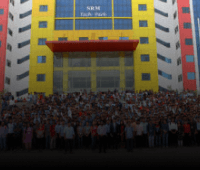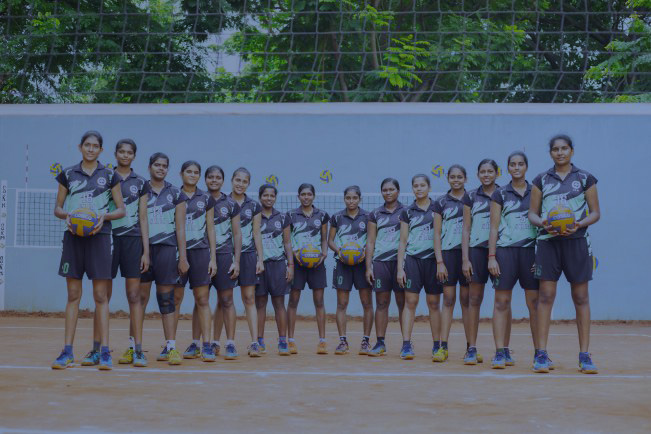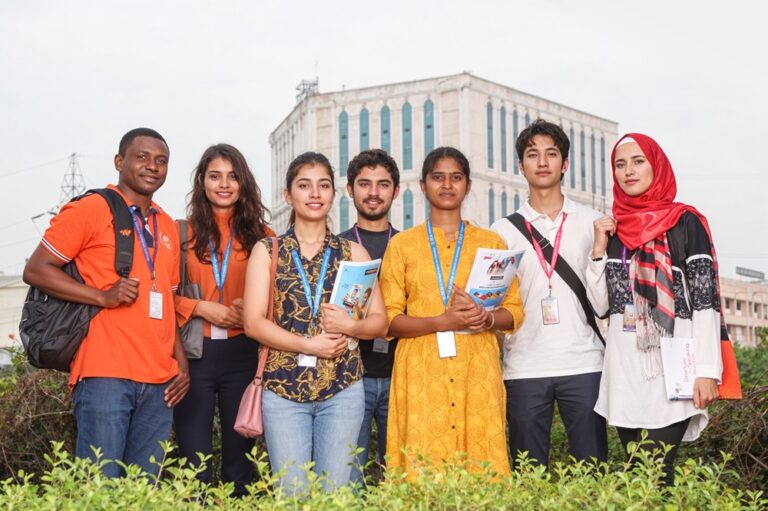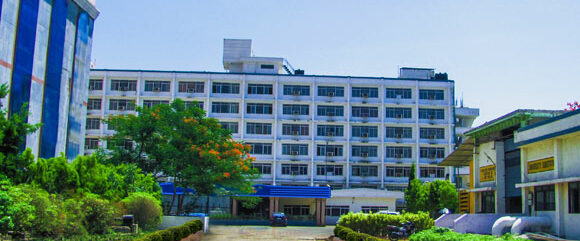Solar Energy Lab
The Department of Mechanical Engineering established the solar energy laboratory to make the students understand the basic concepts involved in solar thermal systems like flat plate collector, concentrator and solar PV systems. This lab is primarily offered to the M. Tech Solar Energy students to undergo the lab sessions of the courses Solar thermal systems and Solar PV systems.
Specifications
- Solar Thermal Training System
- Solar Concentrator Training System
- Solar PV Training and Research System
- Solar PV Grid-tied Training System
- Solar thermoelectric module
- Linear Fresnel Solar Collector
- Thermal energy storage test rig
- Solar PV Emulator
- Solar box cooker
- Solar dryer
Solar Thermal Training system is a compact system in the form of a working laboratory model. This system helps students to evaluate the performance of a Solar water heating System under different atmospheric conditions like temperature, pressure, wind, radiation etc. The experiments can be performed both in the Forced environment and also in the natural atmospheric conditions.
Solar concentrator training system includes the parabolic trough collector to concentrate the solar energy. This system helps students to evaluate the performance of a Solar parabolic trough System under different atmospheric and design parameters with water and oil used as working fluids.

The solar PV training system covers the fundamentals of solar PV system as well as basic research on PV system and related electronics which would be helpful to the engineering students of both undergraduate and postgraduate level.
A Solar Grid-tied System is a grid-connected PV system which links solar power generated by the PV modules to the mains. It acts as an interactive medium where the demand for electricity is fulfilled by the conglomeration of PV and mains. This equipment gives a deep insight into the dynamics of a Grid Tied system and its operation and maintenance.
Solar PV Emulator is a programmable power supply designed to emulate solar panels. With the fast-transient response, the emulator responds to change in load conditions and maintains the output on IV characteristics of the selected panel for a given ambient condition. This instrument is designed to emulate output of solar panels from different manufacturers, variations due to time of the day, effect of season and different geographical locations of installation.
The solar PV training system covers the fundamentals of solar PV system as well as basic research on PV system and related electronics which would be helpful to the engineering students of both undergraduate and postgraduate level.
A Solar Grid-tied System is a grid-connected PV system which links solar power generated by the PV modules to the mains. It acts as an interactive medium where the demand for electricity is fulfilled by the conglomeration of PV and mains. This equipment gives a deep insight into the dynamics of a Grid Tied system and its operation and maintenance.
Solar PV Emulator is a programmable power supply designed to emulate solar panels. With the fast-transient response, the emulator responds to change in load conditions and maintains the output on IV characteristics of the selected panel for a given ambient condition. This instrument is designed to emulate output of solar panels from different manufacturers, variations due to time of the day, effect of season and different geographical locations of installation.

Solar energy laboratory is fully equipped with state-of-art measurements and instrumentations to research solar energy systems; namely, the pyranometer, anemometer, hydrometer, thermal imaging camera, UV radiometer, multimeter and data logging systems. The solar radiation, wind and ambient data are measured at the site. Key research areas are the design of solar receivers for concentrated collectors, solar dryer and drying chambers, thermal storage systems, thermoelectric power generators, solar cookers and thermal management of buildings.

The students are not only involved in the lab-level experiments but also, they are allowed to explore and apply their knowledge in the real-time solar thermal and PV power plants like 100 kW Solar PV plant and Parabolic dish-based steam cooking plant inside the Kattankulathur campus. Students are made industry-ready by the working on indoor and outdoor experiments.

- Determination of parameters of Flat Plate Collector – Forced Mode
- Determination of parameters of Flat Plate Collector – Thermo siphon Mode
- Determination of parameters of Flat Plate Collector for different mass flow rate
- Determination of parameters of Flat Plate Collector for different radiation
- Determination of parameters of Flat Plate Collector – Forced mode of flow at different wind speeds
- Determination of parameters of Flat Plate Collector for Different Tilt Angle
- Determination of parameters of Parabolic Trough Collector
- Determination of parameters of Parabolic Trough Collector for different mass flow rate
- Measurement of VOC and ISC of a Solar PV Panel
- Determination of I-V& P-V Characteristics of a Solar PV Panel
- Determination of I-V& P-V Characteristics of Series and Parallel combination of PV Modules
- Determination of Characteristics of PV Module With a variation of the Tilt angle
- Effect of Shading on Solar PV Module Output Power
- Power Flow calculation of Stand-Alone PV System of DC Load with Battery
- Charging and Discharging Characteristics of Battery
Research facilities in the laboratory
- Parabolic dish solar collector
- Thermoelectric generator
- A thermal energy storage system
- Parabolic dish and box type solar cooker
- Thermal management of a building
- Free and forced convection solar dryer
- The parabolic dish solar collector of 16 m2 aperture area is used to produce a concentration ratio of 120 with the selective solar receiver. This experimental test facility is useful to test the new receiver designs with enhanced energy and exergy efficiency. A thermoelectric module can be used to produce cooling and this is tested by integrating with the solar PV emulator indoor and the real-time testing also may be tested outdoor using concentrated solar collectors. Thermal energy storage is used to design the component level research at the lab-level and the successful implementation of the non-concentrated and concentrated solar thermal systems.
- Optimization of receiver designs
- Thermal performance of the solar dryer
- Thermal performance investigation of selective solar absorbers
- Heat loss study of concentrated solar receivers through outdoor experiments
- Solar radiation and ambient data measurements at the test site
- Study of heat flux on the solar receiver using thermal imaging camera
- Testing of variable heat flux over the PV panels and flat plate collectors
- Senthil R, Cheralathan M. Effect of non-uniform temperature distribution on surface absorption receiver in parabolic dish solar concentrator. Therm Sci 2017; 21(5): pp. 2011-2019.
- Thirunavukkarasu V, Sornanathan M, Cheralathan M. An experimental study on energy and exergy performance of a cavity receiver for solar parabolic dish concentrator. Int J Exergy 2017; 23(2): pp. 129-148.
- Ravita Lamba, S. Manikandan and S.C. Kaushik, Performance Analysis and Optimization of Concentrating Solar Thermoelectric Generator, Journal of Electronic Materials, 2018, https://doi.org/10.1007/s11664-018-6410-7.
- Aravindan S, Giridharan N, Amirdesh Sudhan B. The recent trends in optimization of thermal performance of parabolic trough solar collector. Int J Mech Eng Technol 2018;9(5): pp. 655-661.
- Senthil R, Cheralathan M. Effect of the phase change material in a solar receiver on thermal performance of parabolic dish collector. Therm Sci 2017; 21(6): pp. 2803-2812.
- Sathiyamoorthy K, Mohan D. Chemical and thermal analysis of the sunflower oil used in a parabolic dish cooker for a sensible heat storage. J Chem Pharm Sci 2016;9(4): pp. 2990-2992.
- Ravita Lambaa, S. Manikandan, S.C. Kaushik and S.K. Tyagi, Thermodynamic modelling and performance optimization of trapezoidal thermoelectric cooler using genetic algorithm, Thermal Science and Engineering Progress, 6, 2018, 236-250.
- Senthil R. Enhancement of heat absorption of parabolic dish solar receiver using tapered surface cavities. JP J Heat Mass Transf 2018; 15(2): pp. 181-193.
- Premnath D, Yuvaraj R, Santhanakrishnan R, Arulmani S. Incorporation of phase change material for passive cooling in building roof. J Chem Pharm Sci 2016;9(4): pp. 2745-2749.
- Senthil R. Recent developments in the design of high-temperature solar receivers. Int J Mech Eng Technol 2017;8(8):1223-1228.
- Senthil R, Prabhu S, Cheralathan M. Effect of heat transfer fluid input parameters on thermal output of parabolic dish solar receiver using design of experiment techniques. Int J Mech Eng Technol 2017;8(8):1148-1156.
- Senthil R, Cheralathan M. Simultaneous testing of a parabolic dish concentrated PCM and non-PCM solar receiver. Int J Mech Prod Eng Res Dev 2017;7(6):79-85.
- Senthil, R, Sundaram, P, Manish Kumar, Experimental investigation on packed bed thermal energy storage using paraffin wax for concentrated solar collector. Materials Today: Proceedings; 5 (2018), pp. 8916–8922.
- Thavamani J, Senthil R, Kasiraman G, Ramakrishna C. Synthesizing and characterization of Perovskite solar cells from recycled car batteries. J Chem Pharm Sci 2016;9(1): pp. 669-672.
- Senthil R, Nishanth AP. Optical and thermal performance analysis of solar parabolic concentrator. Int J Mech Prod Eng Res Dev 2017;7(5):367-374.
- Senthil R, Subramanian M, Sundaram P. CFD simulation of phase change material in a concentric thermal storage. J Adv Res Dyn Control Syst 2017;9(3): pp. 126-131.
- Sundaram P, Mohan D, Madhan Kumar S. Performance evaluation of pyramidal slope solar still integrated with PCM thermal storage. Int J ChemTech Res 2016;9(9):2 pp. 30-236.
- Senthil R, Cheralathan M., Enhancement of heat absorption rate of direct absorption solar collector using graphite nanofluid. International Journal of ChemTech Research, 9(9), 2016, pp. 303-308.
- P. Sudhakar and M. Cheralathan, Experimental study on solar air heater using sensible thermal heat storage system, International Journal of Mechanical Engineering and Technology 8(12), 2017, pp. 338–346.
- Senthil R, Cheralathan M., Natural heat transfer enhancement methods in phase change material based thermal energy storage. International Journal of ChemTech Research, 9(5), 2016, pp. 563-570.
- R. Senthil, Effect of uniform and variable fin height on charging and discharging of PCM in a horizontal cylindrical thermal storage, (SCIE indexed), Thermal Science, 2017, DOI: https://doi.org/10.2298/TSCI170709239S.
Profile
This lab is primarily offered to the M. Tech Solar Energy students to undergo the lab sessions of the courses Solar thermal systems and Solar PV systems.

















